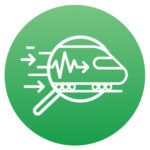Railigent Class 700

Relevant RTS critical priority(ies):
Reliable and easy to maintain
“If it ain’t broke, don’t fix it”, as the old adage says. Avoiding maintenance completely is always the maintenance engineer’s objective, but that is not always possible. The next best approach is predictive maintenance, based on performance, or on condition. The evolution of increasing numbers of digital systems on-board trains has increasingly permitted the train to communicate its condition to a control centre, permitting the maintenance team to know what state various systems are in. Then the challenge became to identify what actually mattered, and what was just “interesting”, and planning and executing maintenance using that knowledge.
Railigent is the platform that provides a set of standard tools for data processing, storage and analytics. A key requirement is reliable train-to-shore communication, Railigent Connect, which enables real-time, automated data transmission from any rail system to landside operations.
Once all the data has been collected, advanced analytics and expert domain know-how are applied to convert the variety of data into an intelligent, customised user interface. Targeted, role-specific information for operation and maintenance are derived from the same underlying data: output ranges from highly-aggregated Key Performance Indicators for managers to detailed root-cause analysis for maintenance staff in the depot.
Using Railigent facilitates increased availability, operational risk reduction, life-cycle cost reduction and increased utilisation rate, as well as condition-based and predictive maintenance. Train drivers can be given the most effective information to manage a defect in-service without resort to Control Centre advice. Maintenance can increasingly be performed away from a depot, using work orders generated by the trains, attending to only those parts which are known to be operating outside of their intended parameters, or having reached a threshold condition. The systems also permit improved passenger engagement, in real-time, creating opportunities to address their problem and improve satisfaction with their journeys, e.g. by identifying which parts of the train have space.
Back



